It’s a calm summer day in Holland, Michigan, a thirty some thousand people city in the state’s western region. A near 200 miles from Detroit, Holland is not a traditional automotive headquarters. Driving through town, past the tulip beds or one of the many churches, there are few if any clues Holland is really at the epicenter of the automotive industry. Holland might generate a reaction not unlike many quiet American communities: that it’s a good place to settle down and raise a family.
Core Platforms
Many of the most influential ideas regarding the future of mobility will emerge from Holland. It’s part of the reason why Faurecia, one of the world’s largest automotive suppliers, has set up shop here. The company operates in 35 countries, employs nearly 99,000, and has over 630 programs in development at any given time. Their largest customers include VW, Ford, Renault-Nissan, and PSA. In North America, Faurecia recorded over 5 billion in value-added sales last year, with a workforce 21,000 strong.
“We were a bit more European focused historically and that is why the brand is less known here in North America but that is changing,” said Jim Hotary, Director of Innovation, Faurecia Automotive Seating.
Faurecia is comprised of three business groups related to the modern automobile: seating, interiors, and clean mobility. Across these platforms, the company helps automakers accomplish a range of goals, from weight and emissions reduction, to increasing comfort and safety for the driver. In North America, vehicles like the Chrysler Pacifica, Audi Q5, and Lincoln Continental uniquely benefit from Faurecia’s designs and products.
“For every customer in every program, we have a different mix of products, and there are different technologies involved,” Hotary explained. “We like to make sure we understand the customers of our customers; how they are unique and how their use cases differ.”
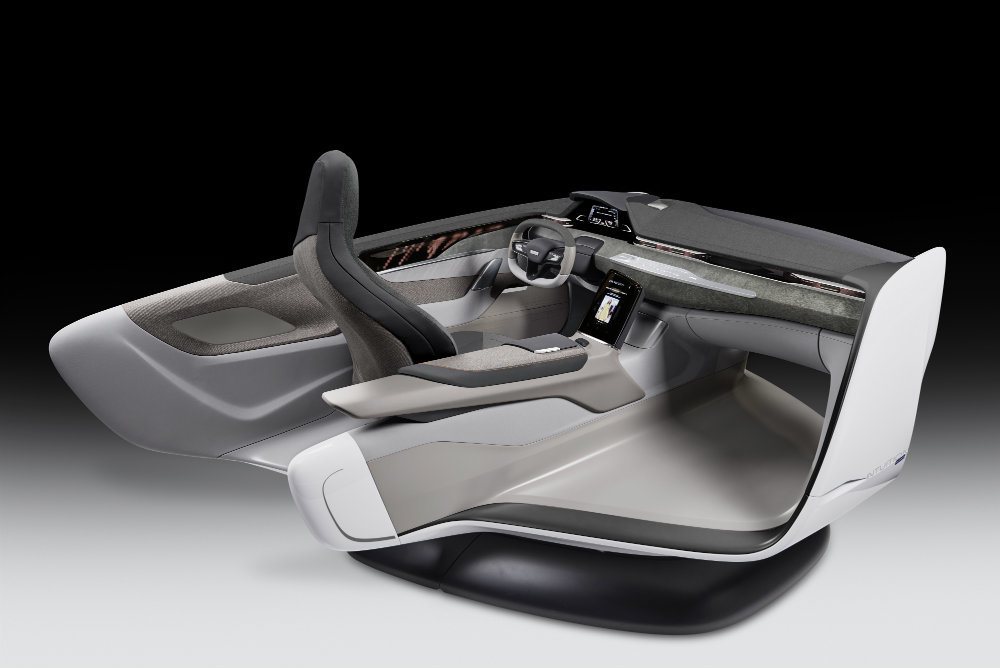
Strategic Distance
Globally, Faurecia has 300 sites and 30 R&D centers. So why the need for Holland? Why the need for this small community on the heels of Lake Michigan? It doesn’t make sense until the understanding is had that Faurecia considers themselves a “make tank” not a “think tank.” Their quaint upstairs office in a Holland plaza, once inhabited by a furniture manufacturer, is the embodiment of that philosophy.
“We call it strategic distance; we are like a secret outpost but we think that is an important tool to have,” Hotary said. “We are close enough that we can be in Detroit to have customer meetings and work with the team there, but far enough away so we can have the focus and, in some ways, the permission to experiment with things that are a little crazy.”
The automotive industry is a bustling metropolis unto itself, a 24-hour affair that rarely, if ever, concedes. It’s a vast machine generating a lot of noise but this Faurecia team is away from the sound waves, thriving in their Holland office space which resembles more a promising startup than a multinational corporation. The team is diverse in their backgrounds, from engineering and business to marketing and consumer research. The mix of competencies allows the team to rigorously vet and examine the next batch of innovative ideas or disruptive solutions that await our future automobiles.
“Because of the cross-functional nature of the team here, we are able to think more holistically about what the products will be,” Hotary said. “We are trying to understand what will matter to end consumers and how mobility needs are shifting.”
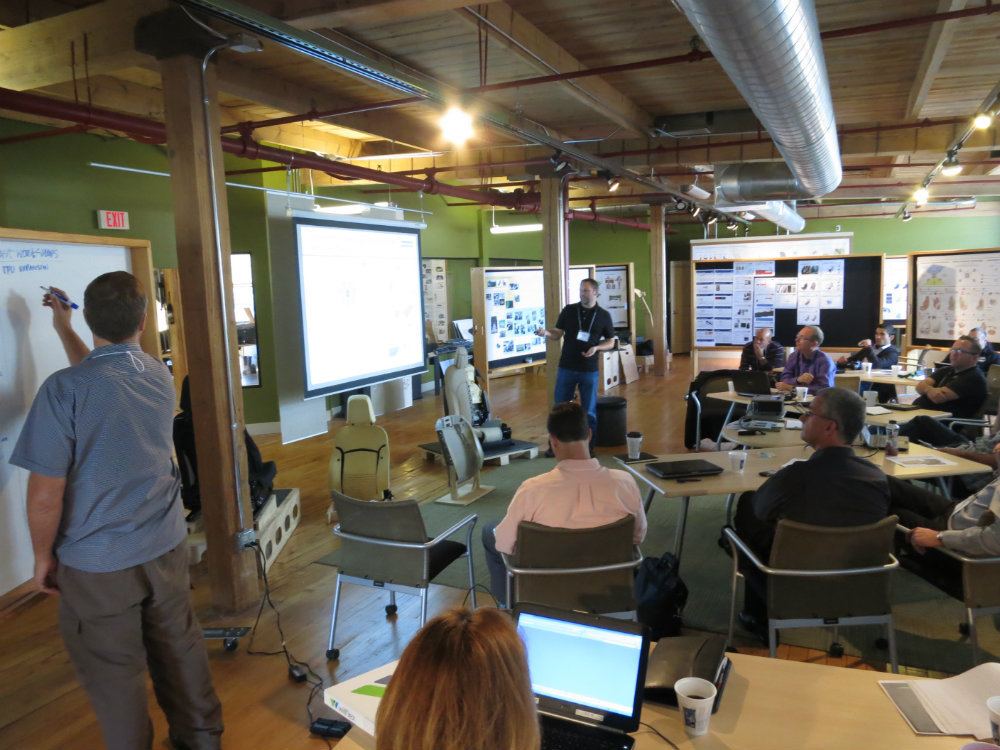
Learn Fast Approach
The Holland space easily allows for mock-ups based on certain in-vehicle situations. The goal is to get an idea of what is feasible or possible before money and time is spent developing something that, for whatever reason, doesn’t work. The mock-ups allow the team to see potential pitfalls with a product or design well ahead of time.
“If you look at how a lot of organizations develop ideas compared to a learn fast approach: I mean, I have seen companies spend 6 months, 12 months, even 2 years building a product, and going into CAD to develop something before they have even tried to experience it,” said Matthew Benson, Innovation Manager, Faurecia Ventures.
Hotary and Benson lead us through an experience mock-up that proved rather eye-opening, showing how one could invest a lot of resources into the next “big automotive idea,” but completely miss the mark. Our simulation, or mock-up, was an autonomous vehicle. We wanted it so the occupants could face each other for more quality time when the car was in automation. At that point, Benson took two chairs from around the table and set them directly across from each other. I sat in one, Benson in the other. Granted, we were not in an actual vehicle, but it quickly showed how awkward and intrusive it would be if we were resolved to this position for the entire drive.
“With these experience mock-ups, our goal is to in 30 seconds, 30 minutes, one day, or one week, get to a point where we can have some kind of experience to know whether or not something is worth pursuing,” Benson said.
“You gain tremendous insight and you realize what the issues are immediately when you mock-up a given situation,” Hotary added. “We know how to make seats rotate, that’s not rocket science, but what we are trying to answer is do people actually want to be in those positions, and if they do, how do we manage that in the vehicle.”
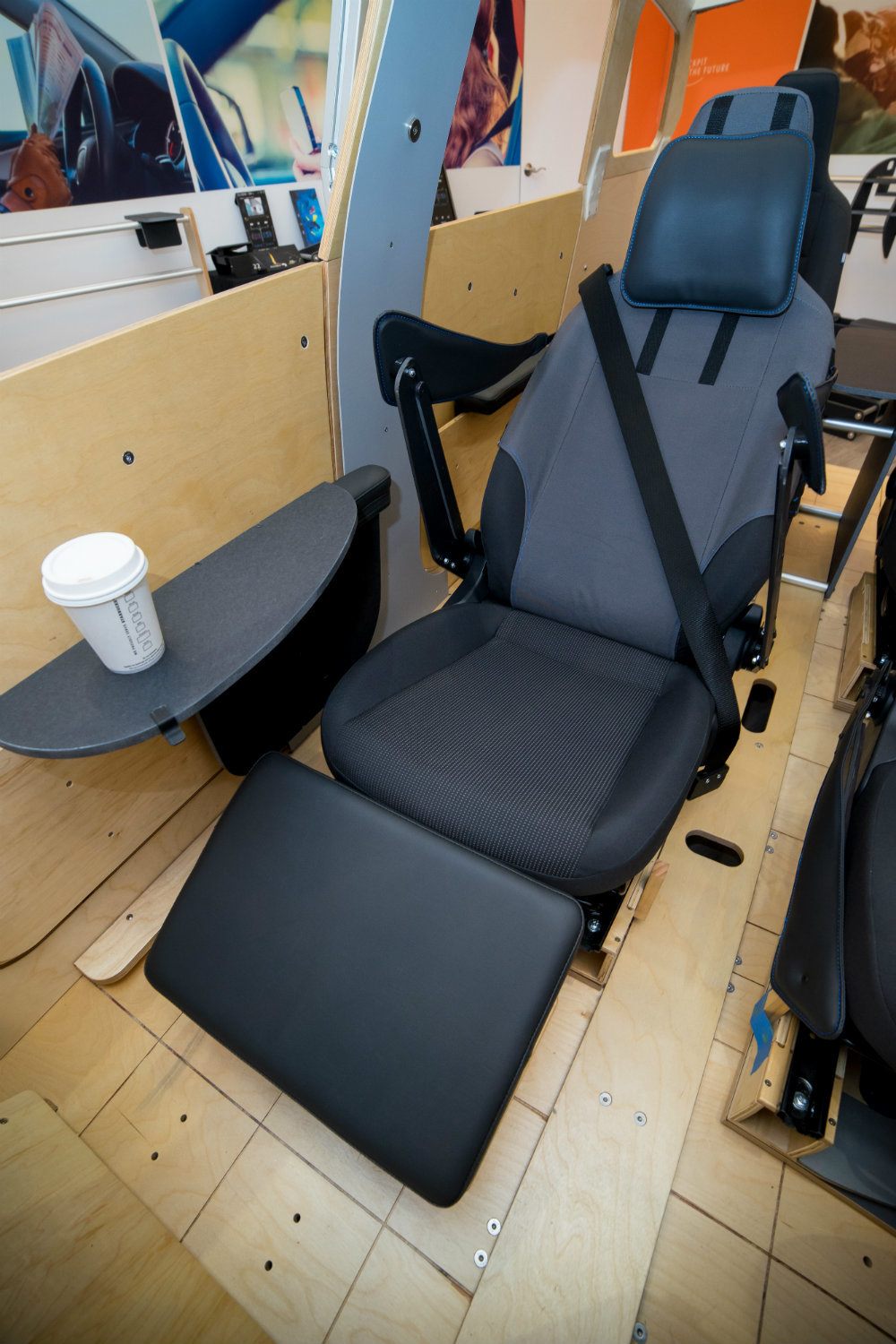
Inspiring Mobility
Faurecia’s Holland space is purpose-built for the learn fast approach. Once an idea or in-vehicle simulation is conceived, the team will pull out the hot glue gun and plywood from the small workshop in the corner. On the opposite wall, they tinker in the electronics and software area, eventually combining the two to create the appropriate experience model for an endless amount of in-vehicle scenarios. The focus is to determine what will be meaningful for car owners as mobility trends evolve.
“You have to build things and experiment with them and get people around them,” Hotary explained. “If you don’t, then you are not able to see the problem correctly and really get to the core of the issue.”
The future of mobility is changing and with it, our expectations and desires about how vehicles should perform and function. The possibilities are limitless, especially when things like ride sharing, alternative powertrains, or fully automated vehicles are introduced. There are new business models and innovation ideas popping up in the automotive universe constantly, like the little creatures in a whack-a-mole machine at the local fair. Yet Faurecia believes such ideas are cheap and the real emphasis should be placed on how these now uncharted territories will one day (if they don’t already) affect how we purchase, own, and even perceive vehicles.
For example, with automated vehicles, elderly and disabled people may want to utilize one. A percentage of the population now has access to mobility where they didn’t before, so how does that affect things? Hence ingress and egress and comfort become very important. What about an executive who wants to conference call his corporate team in the vehicle? Suddenly acoustics and connected systems become a focal point. How about the couple who buys an automated car looking to rekindle their romance on an anniversary getaway? Now the mock-up we did – where we discovered the seats facing each other were uncomfortable – carries significant relevance.
“We call our team the Cockpit of the Future but it’s not actually cockpit, it’s cockpits,” Benson said. “There may be different situational needs that emerge but we are trying to provide solutions we can leverage across many things – what we would call a technical brick – that we can use to solve multiple needs across different types of vehicles, situations, and users.”
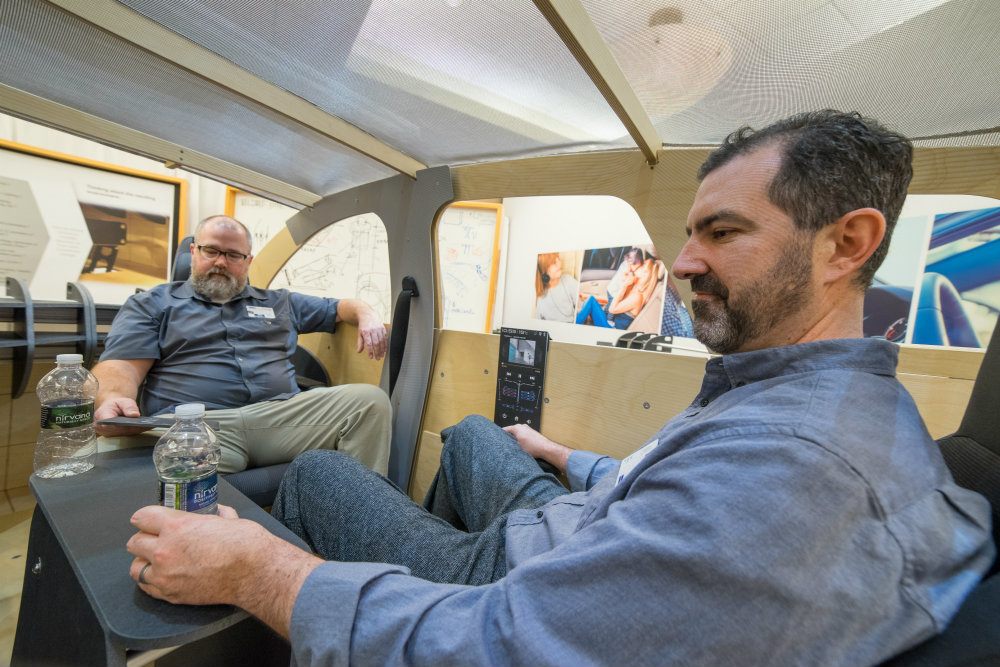
Open Innovation
The Cockpit of the Future sits in the middle of Faurecia’s Holland office, a vehicle exoskeleton of wood and metal known as “the buck.” The structure can be molded and maneuvered to resemble many of today’s automotive and architectural setups. The buck has an artificial steering wheel, center console, dashboard, seats, and many of the same things we see in cars today. Yet in the buck, they can be moved, interchanged, and even removed depending on the situation. Consider the aforementioned executive who needs to manage the corporate team from the road. Let’s imagine the vehicle they want is a hybrid luxury sedan with an advanced level of automation. And let’s say one of their desires is that the environment inside allows for family interaction because when they are not working, their grandchildren will be with them.
The buck can then be configured to show how that particular vehicle, in that particular scenario, might need to look.
“Today’s trends are driving thousands of different combinations, especially since we are going to see more connected vehicles,” Benson explained. “Our role is to enable the future of mobility, and in the buck, we can start thinking about how a vehicle is setup in a particular manner. We understand how much value is in these different scenarios by using predictive cabin data and analytics to ultimately personalize these experiences for the end user.”
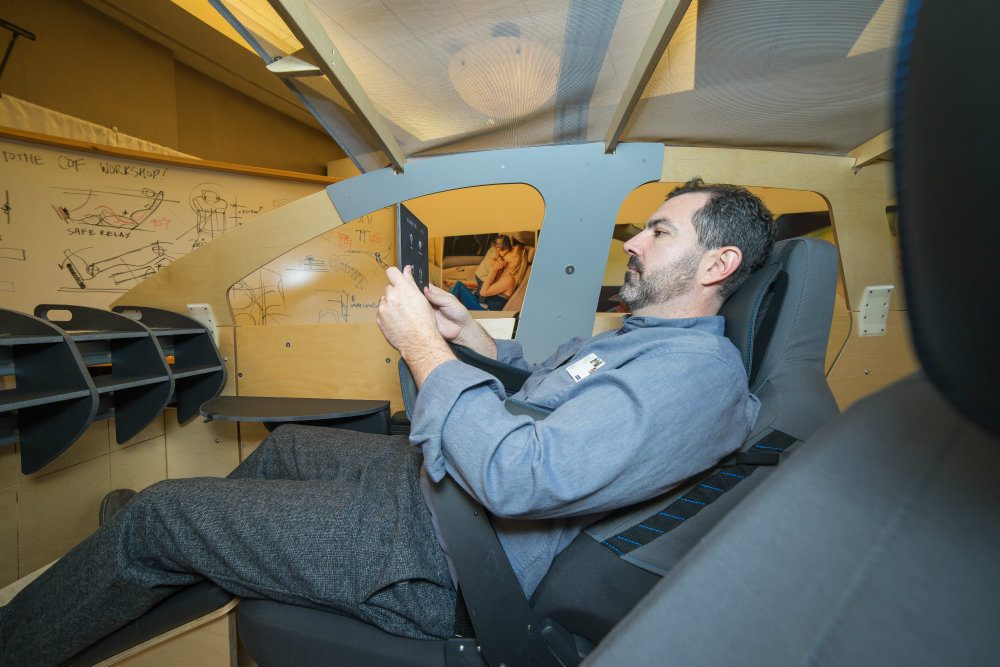
Purpose Driven
On the trip back to Detroit, I envisioned how my own vehicle might look a few years down the road with some of the things I had seen at Faurecia. I would play them out in my head: “okay, so we have an SUV, the customer is a baby boomer, and they need to get work done on their commute, but want a sense of performance in the vehicle, etc. etc.” The combinations came one after another, with no shortage of available scenarios, but I sensed what some consumers may feel when confronted with today’s vast curve of automotive trends. Is there a space for yours truly? Is there a future automobile – in the midst of this looming yet unknown world of autonomy, and all this talk of mobility trends – is there something that will still fit me and my family?
Faurecia believes there is.
“This is what we focus on,” Hotary said. “This is what we get up every day to do.”
Carl Anthony is Managing Editor of Automoblog and resides in Detroit, Michigan.


